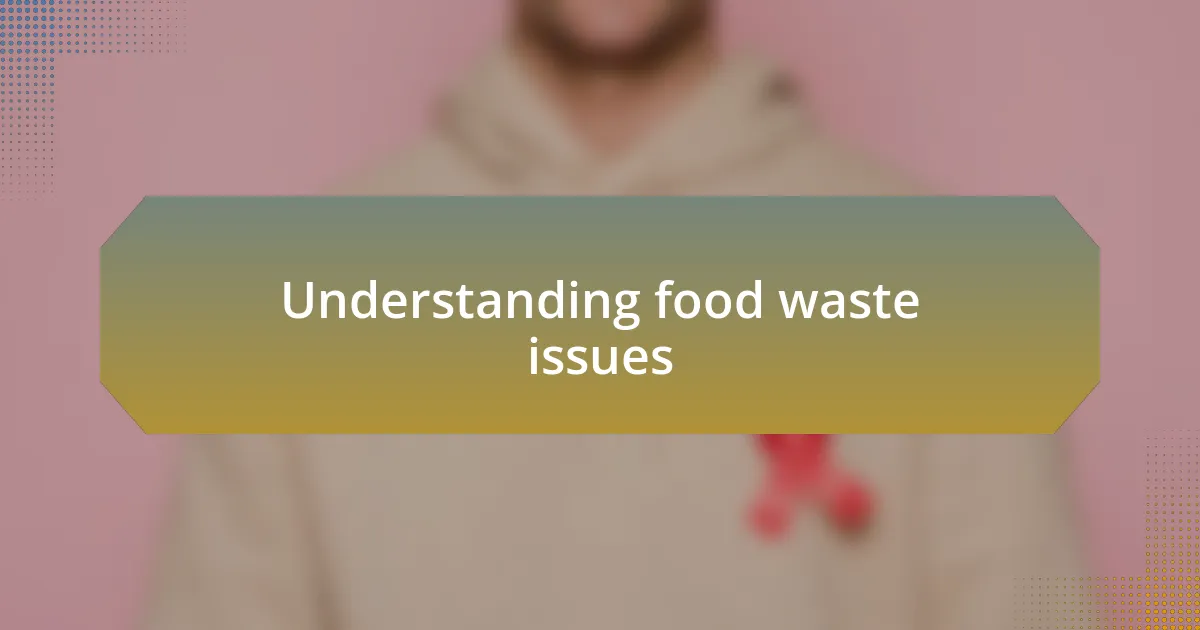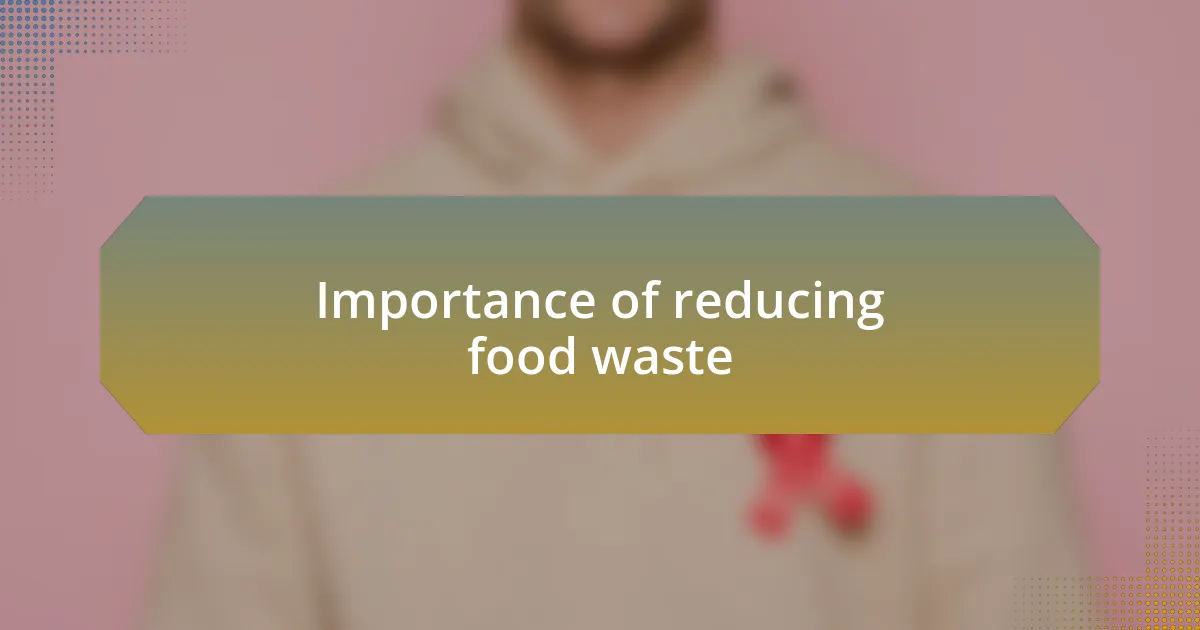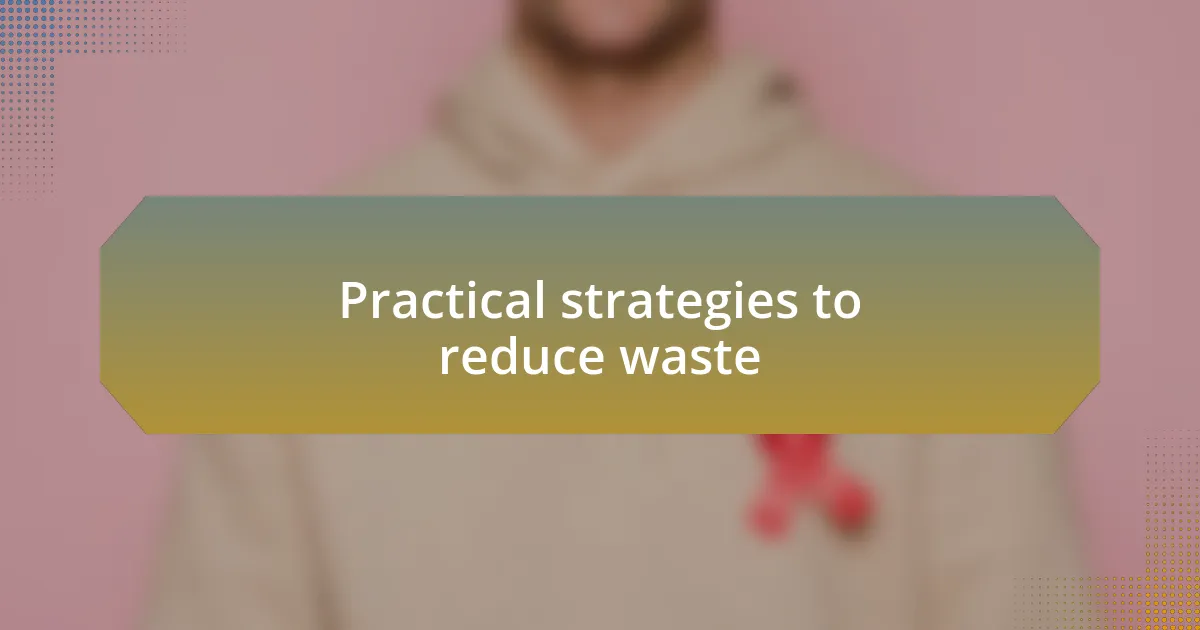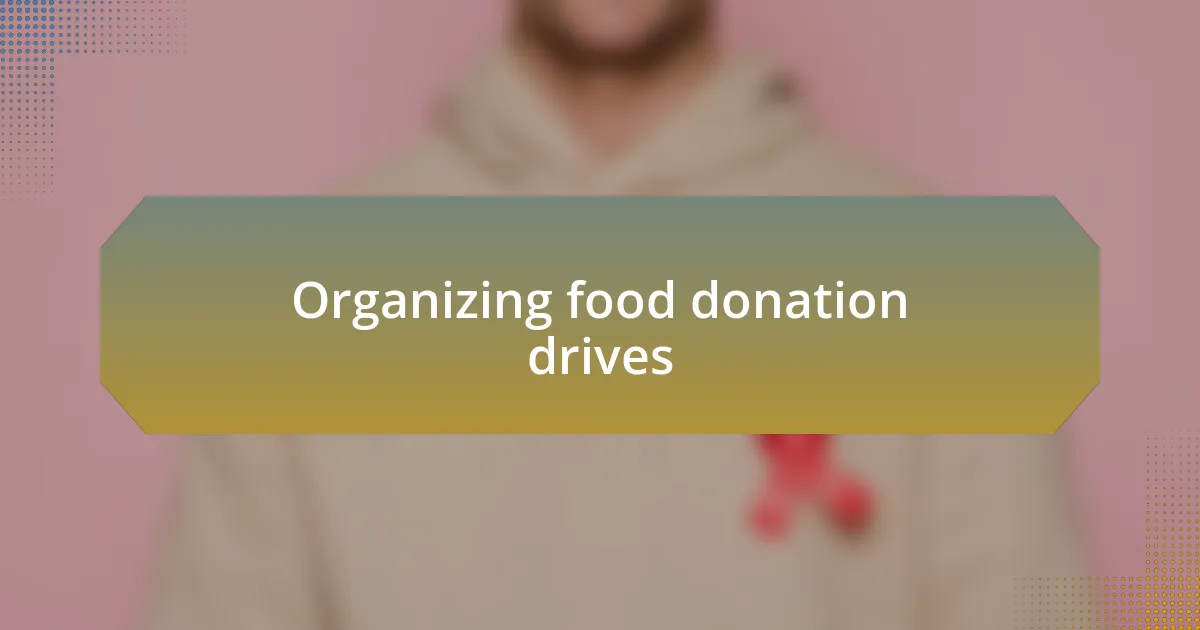Key takeaways:
- Food waste significantly affects both the environment and vulnerable communities, with nearly 30% of the global food supply being wasted, mostly in households.
- Reducing food waste can improve economic conditions for families and allow charities to allocate resources to essential services, enhancing their ability to support the homeless.
- Practical strategies like meal planning, creative use of leftovers, and community involvement can effectively minimize food waste and foster connections.
- Partnering with local charities and organizing food donation drives build community spirit and ensure surplus food reaches those in need while raising awareness about food waste issues.

Understanding food waste issues
Food waste is a pressing issue that affects millions globally, impacting both the environment and the livelihoods of vulnerable groups. I remember visiting a local shelter and seeing how much fresh produce was discarded simply because it was deemed too “ugly” to sell. It struck me then how our perceptions can lead to wastefulness, even when that food could have nourished those in need.
Have you ever considered how much food we toss aside in our own kitchens? Almost 30% of the world’s food supply is wasted, and much of it occurs in households. I often wonder what it would be like if every family made a conscious effort to reduce their waste—how many more meals could we provide for those who are hungry?
The emotional weight of food waste is hard to ignore, especially when I think about the families struggling to put meals on the table. Just last week, I watched a documentary highlighting how perfectly good food from restaurants goes to waste daily, while nearby, those experiencing homelessness wait for help. It’s a striking reminder that behind the numbers, there are real lives affected by our consumption habits.

Importance of reducing food waste
Reducing food waste is essential not only for addressing hunger but also for protecting our environment. I recall a time when I volunteered at a community garden, where we repurposed surplus vegetables into meals for the homeless. The joy on their faces as they received fresh, nutritious food reinforced my belief that every bit counts. If we all examined our habits and made small changes, imagine the positive ripple effect on both our plates and the planet.
Moreover, when we waste food, we waste valuable resources like water, energy, and labor that went into producing it. The sheer amount of water used to grow crops that end up in landfills is staggering. It makes me think: what if we treated every leftover like gold? The environmental impact of reducing food waste could be transformative, and I often wonder how much better our world would be if we embraced this mindset.
Lastly, the economic implications of food waste cannot be overlooked. Families struggling to make ends meet often bear the brunt of wasting food, which equates to wasting money. I’ve seen friends stress over grocery bills, only to find half-eaten items forgotten in their fridges. If we collectively reduced food waste, not only would we nourish more people, but we’d also create a more sustainable economic landscape for everyone involved.

Benefits for homelessness charities
When homelessness charities receive surplus food, it often translates to more nourishing meals for those in need. I remember a day at a local shelter when a grocery store donated fresh produce that would have otherwise been thrown away. The volunteers and I quickly turned those items into vibrant dishes, and the heartfelt gratitude I witnessed was a reminder that food is not just sustenance; it’s a source of dignity.
Furthermore, collaborating with local businesses for food donations can strengthen community ties and foster a spirit of generosity. It’s amazing how sharing resources can create a network of support. I can’t help but feel inspired when I see various organizations come together, each doing their part; it shows that compassion has the power to create real change in people’s lives.
By reducing food waste, charities can allocate more funds to vital services like job training and housing assistance. I once spoke with a charity director who shared how surplus funds, previously spent on food purchases, allowed them to expand their outreach programs. This shift not only maximized their impact but also sparked hope among the homeless, showing them that resources are available to help them reintegrate into society.

Practical strategies to reduce waste
One practical strategy I’ve found effective is meal planning. By thoughtfully planning meals for the week, I’ve significantly cut down on impulse buys and excess ingredients that often end up in the trash. After I started keeping a shopping list, I realized how often I used to buy items without a clear purpose. Have you ever opened your fridge to find wilted produce? It’s a quick reminder of what effective planning can prevent.
Another approach is getting creative with leftovers. For instance, I often make a ‘leftover night’ where I use whatever food I have on hand to whip up a unique dish. Last week, I combined some roasted vegetables with pasta and topped it off with a bit of cheese. My family loved it! It made me think about how incredible it is that you can transform what might seem like scraps into something delicious and satisfying.
In addition, involving the community can be a game changer. Hosting food drives or cooking workshops not only educates people on reducing waste but also builds relationships. I once partnered with a local community group to organize a “zero waste” cooking class. Participants shared their own tips and tricks, and together we created a vibrant meal from odds and ends. The joy on everyone’s faces as we sat down to eat was truly a testament to the power of collaboration in minimizing waste while fostering connection.

Partnering with local charities
Partnering with local charities can make a substantial impact on reducing food waste, and I’ve seen it firsthand. For example, my local food bank runs a program where they collect excess produce from farmers’ markets. When I volunteered there, it was amazing to see how much good food was saved from going to waste and, instead, transformed into meals for those in need. Have you ever considered how many edible items end up in landfills just because they weren’t sold?
Working directly with charities not only helps manage surplus food but also fosters community spirit. I remember teaming up with a charity that organized a weekly meal for people experiencing homelessness. Together, we sourced surplus items from local cafes and transformed them into hearty, nutritious dishes. The smiles and gratitude from our guests reminded me why it’s so important to ensure that food doesn’t just sit around unused.
Moreover, this partnership can open doors for education on food waste issues. I often share insights on meal preparation and food storage when collaborating with local charities. It’s rewarding to see participants’ eyes light up with understanding when they learn how to maximize their grocery purchases. Isn’t it invigorating to think that we can turn our collective awareness into action?

Organizing food donation drives
Organizing food donation drives can be a fulfilling way to bring the community together while ensuring that surplus food reaches those who need it most. I once spearheaded a food drive at my local school, and it was heartwarming to see families rallying together, bringing in non-perishable items from their pantries. It really struck me how, when we collectively focused on a cause, even small contributions could accumulate into a significant impact.
In planning these drives, I learned that creativity plays a key role. For one event, we set up a friendly competition among classes to see who could donate the most food. The excitement was palpable, and not only did it boost participation, but it also sparked essential conversations about food waste. Have you ever noticed how a little competition can transform even the simplest tasks into something more meaningful?
Furthermore, engaging with local businesses can amplify your outreach efforts. I remember reaching out to a nearby grocery store, and they generously provided us with discounts for sweetening the deal. This collaboration not only spotlighted their community commitment but also ensured our food drive was stocked with appealing items. Isn’t it inspiring when local businesses step up to support meaningful initiatives like this?

Personal tips for mindful consumption
Mindful consumption starts with being aware of what we buy and how much of it. I remember a time when I struggled with overstocking my fridge. Ingredients would often go unnoticed, leading to waste. Now, I create weekly meal plans that help me buy only what’s necessary, allowing me to enjoy fresh meals without the guilt of throwing away spoiled produce. Doesn’t it feel great to avoid that last-minute grocery dash that often ends in forgotten items?
Another tip is to embrace seasonal foods. I recall visiting a local farmer’s market and being amazed by the vibrant produce available. Not only do seasonal foods taste better, but they also tend to be fresher and more affordable. By choosing these items, I feel connected to the community and its rhythms, and it reduces the likelihood of items sitting around for too long. Have you ever tasted the difference between a tomato that was picked yesterday versus one that had traveled thousands of miles?
Lastly, storing food properly can make a significant difference. I’ve had my share of wilted greens and stale bread, but learning the ins and outs of food storage has been a game changer for me. Utilizing airtight containers and understanding how to prioritize certain items can prolong their life. It really struck me how small adjustments can lead to meaningful reductions in waste. Have you experienced the satisfaction that comes from knowing you’ve succeeded in keeping food fresh and delicious longer?